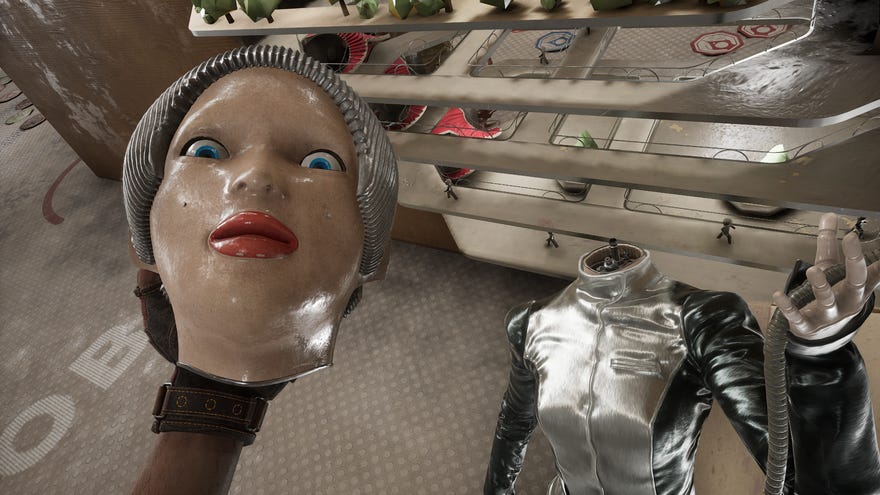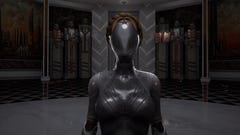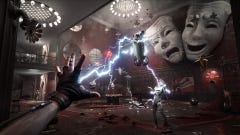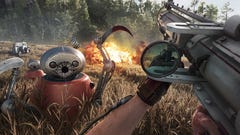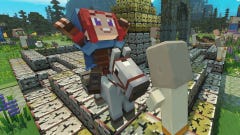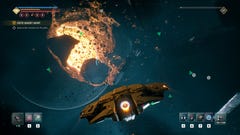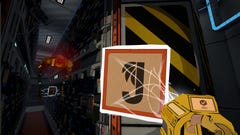Atomic Heart review: a mad science experiment that yields mixed results
Yammer and sickle
I’ve played a lot of strange games, but never one that lurches between greatness and bafflement as hard or as fast as Atomic Heart. It’s a fascinatingly chaotic medley of ideas, and a rare FPS that lacks even the slightest whiff of battle pass-peddling live serfdom, but those ideas so often fail to gel that it can feel like a game made by several different dev teams. For a shooter set within an alternate history Soviet Union, it could perhaps have used some more central planning.
Of course, Atomic Heart was not made by several teams. It’s the debut game of just one, Mundfish, and as a first attempt it’s impressively ambitious. After a gorgeous intro aboard a flying city, the first of many BioShock series influences, irritable special agent P-3 (that’s you) and his snarking AI-powered glove (that’s your hand) are deposited into one of the massive science complexes that made this USSR even more of powerhouse than it was in reality. This one’s suffering from a combined robot uprising/zombifying plantlife outbreak that the brass would rather keep quiet, and they’ve deemed one bloke with some guns, improvised melee weapons and Plasmid-like glove powers enough to quell it. For the motherland, yeah?
The Irrational inspiration is clear. The stonking spectacle of Facility 3826, as the mountainous base is known, is a match for some of the best views throughout Rapture and Columbia, and the first few hours in particular lean into a similar survival horror feel to the original BioShock’s early stages. But there’s more than a hint of Half-Life 2 here as well, in the way that Atomic Heart gives each chapter a certain flavour before dropping it and moving on to the next. Horror turns to open-ended action, which turns to puzzling, which turns to corridor shooting, which turns to psychological drama, and so on. Like I say, it’s ambitious, and a lot of the time it all works quite well.
When it doesn’t, though, the gap between what Atomic Heart gets right and what it gets wrong looks wider than Russia itself. Take the combat. Much of this is technically sound: ballistic weapons have a delightful kick to them, with shotgun blasts sending rogue bots tumbling backwards or scything them clean in half, and once you get a feel for dodging, even one-on-one duels can thrill. Watching for attack telegraphs is crucial, and getting in some return hits after a perfectly timed dodge never fails to satisfy.
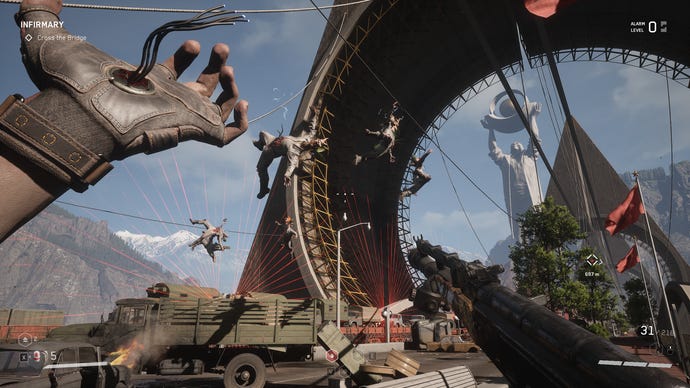
The upgrade system, fuelled by tat scavenged from the facility’s many drawers, also successfully nudges you into adopting a personal playstyle without the sense that you’re being forced. I ended up as a highly mobile skirmisher, using extra dodge charges to zip in and out of buckshot range and deploying the glove’s Mass Telekinesis power to drag foes aloft for breathing room.
All the components for a great shooter are here, then, but there are problems. The first is that Atomic Heart stretches out certain encounters far too long for its own good. The high durability of most enemies – even cannon fodder humanoids take several headshots – can make for a fun challenge when it’s, say, 1v3, but you’re often facing twice that many or more, and there’s only so much meat you can grind before excitement turns to frustration. Worse, both robotic and organic enemies can replenish their ranks mid-battle, either through repair drones or flying parasites creating more flower monsters out of the facility’s dead. Fail to prioritise these irritants over the ones that are actively firing rockets at your feet, and a previously exhilarating dust-up can become a chore. Not to mention a drain on already limited ammo and health supplies, necessitating yet more drawer-rummaging.
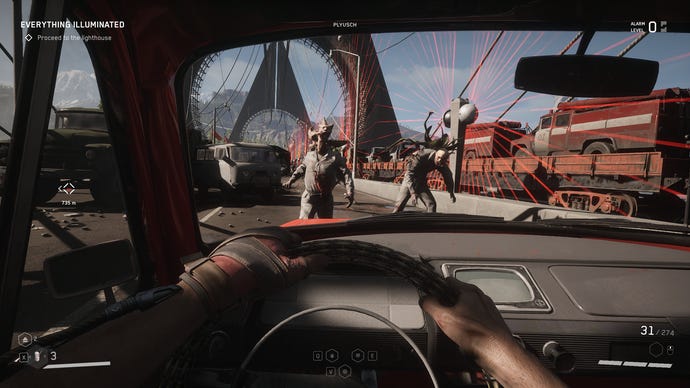
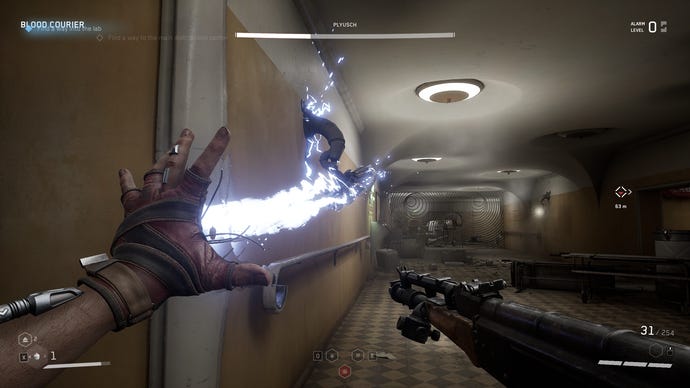
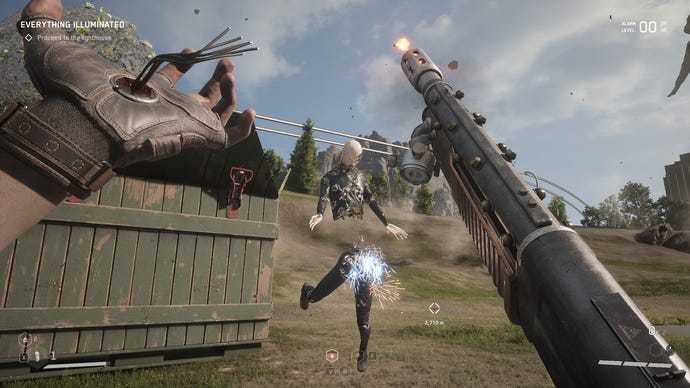
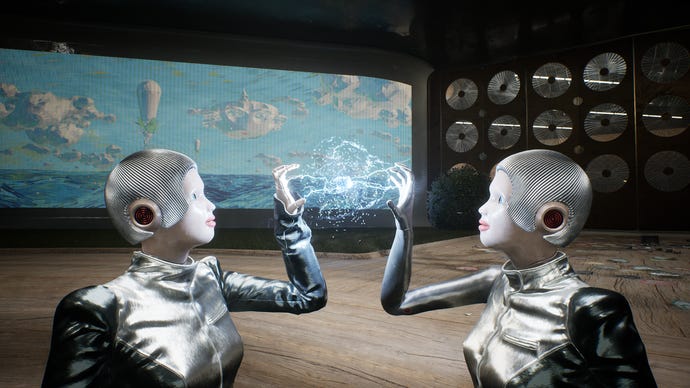
The selection of glove powers is disappointing too. The always-equipped Shok, a jolt of electricity, never stops being useful but the only ability I really cared to upgrade was the telekinesis lift. While the cryo freeze effect looks nice, it’s ultimately an inferior crowd control tool to Mass Telekinesis, and not one but two of the others are only good for boosting the elemental damage of Shok and certain upgraded weapons. There’s almost no interesting way in which these powers interplay with the environment or each other: they’re mechanics without systems, if you’ll forgive the immersive sim lingo.
Stealth is technically an option, but enemies are usually too eagle-eyed and sound-sensitive to fall victim to it, and it’s not really a style you can spec for with upgrades. Your primary method of interacting with the world of Atomic Heart is to blast holes in it, which again, can be mightily enjoyable one minute only to become a slog of attrition the next. Which is even more of a shame, given some of the marvellously designed arenas. Cavernous Soviet-punk laboratories, glistening museum halls, ballet theatres in the midst of an android dance performance… Atomic Heart regularly serves up fantastic sets for its battles, even if what follows is only occasionally worthy of them.
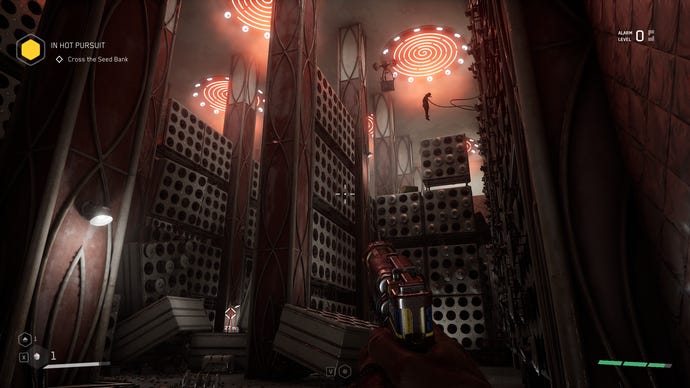
P-3 himself presents another duality problem. Those opening hours, with their survival horror focus? This guy talks through them like an annoying cinemagoer. Barely a minute passes without a sweary rant or sarky quip, often in the form of attempted banter with the glove, and even the lines that don’t undermine the rest of the game’s tone fail to be endearing or funny. "Fuck my life", he moans, unironically and about sixty years before it became a phrase. "Crispy critters!", he inexplicably exclaims, two or three times per hour for the full length of Atomic Hearts’ 15-ish hour runtime. Not every game needs prestige characterisation, but I’d prefer if my own mouthpiece wasn’t spoiling the atmosphere that Atomic Heart otherwise does a pretty fine job of building up.
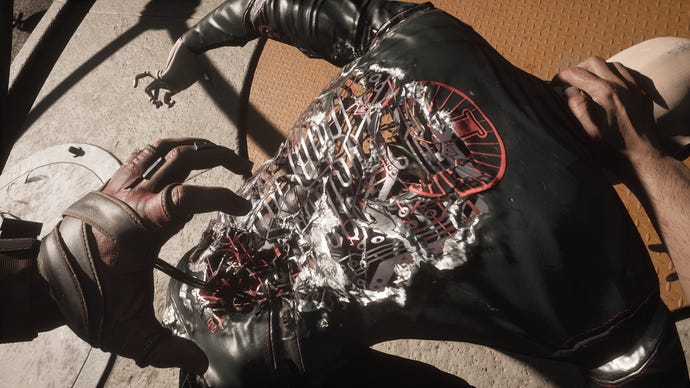
The incongruity of P-3’s chatterboxing is one of several artistic and/or design choices that will just leave you wondering: “Why is that even here?” Another: the open world. Once you escape the infested nightmare of that first research station, you’ve got free run of Facility 3826, and can head to the next story objective or go hunting for weapon mods in the various subterranean test sites dotted about. The map itself is beautifully made, with ornate superstructures carving into lush forest, and the test sites make for worthwhile, puzzle-heavy asides. But besides acting as a transitional space to reach them, the open world serves no structural purpose. The story mainly takes place in self-contained, underground facilities, and there are no meaty sidequests to do or lore scraps to find between these big missions. Attempts at exploring are usually met by sheer cliffs or laser grids hemming you inside set boundaries, much smaller than what the map menu would have you believe.
Ultimately, your only options in this empty world will be to proceed to the next waypoint or to get in a scrap with some patrolling bots, the latter being something you can do plenty of during actual, fully-designed combat encounters if you stick to the former. And it’s not even there to preserve a BioShock/HL2 style unbroken perspective – on several occasions, Atomic Heart rolls conventional cutscenes that end with P-3 in a completely different location. Between this, the general lack of things to do, and the fact that the game is at its best during tight fights inside carefully designed arenas, the inclusion of an open world is a deeply strange one.

Other concepts might have a stronger logical basis, but are then left undeveloped or even dropped entirely. Early on you meet Nora, an AI that lives inside the facility’s vending machines/upgrade stations and coos at P-3 entirely in filthy double entendres. It’s not funny, and again, it’s not tonally fitting, but you can sort of see what they were going for in a kiosk with a personality. But then, after a couple of introductory meetings, she disappears, replaced by the machine’s polite stock voice. Without comment, Nora largely vanishes from the rest of the adventure, only appearing for a couple of seemingly random cameos hours later. Why bother with her in the first place? Then there’s one, particularly massive robot that’s built up as a threat, only to permanently disappear – unfought – before the end of the first act.
It can all feel a tad disjointed, especially when Atomic Heart is so fond of telling and not showing. On two separate occasions, an upcoming boss fight is spoiled by a freeze-frame text box containing tips on how to beat them. There’s heaps of exposition dialogue between P-3 and the glove AI as well, so much so that the levels aren’t always long enough to accommodate them. It’s often possible to walk into a room and trigger a new dialogue sequence before the previous one is even finished, which cuts the latter off mid-sentence.
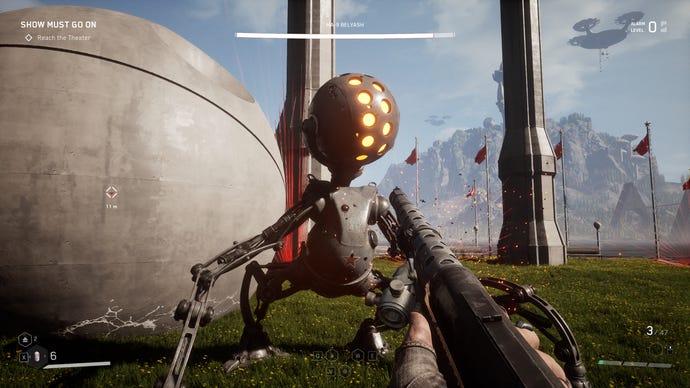
Yes, Atomic Heart may possess the look of a AAA blockbuster, but it has Eurojank DNA. Voiceovers crashing into themselves might be the least of it: I’ve seen the glove’s item pickup ability glitch out and permanently lodge a projector reel in my hand, boss health bars get stuck on-screen long after they’re dead, and an objective marker appear well before the mission it actually ended up being for. On one darkly funny occasion, a defeated creature sprang back up, like Grandpa Joe getting a golden ticket, and proceeded to attack thin air while I passed by unaccosted.
This is not to downplay Atomic Heart’s technical accomplishments in other places. It really does look superb, visually and aesthetically, and despite this it runs on PC with much greater ease than other recent big releases like Forspoken and Returnal. An RTX 3070 with Quality DLSS enabled is enough to get the highest ‘Atomic’ preset purring at 1440p, hitting 90-110fps in the open world and at a solid 144fps in most interiors. The same card and settings will generally stay above 70fps at 4K, too. (Oddly, though, the much-advertised ray tracing settings weren't enabled in the review build I played; I've contacted Mundfish to check that these will be ready for launch. Update: they will not! Wow.)
Outside of the dialogue issue, Mundfish’s sound team have also done great work. Two of my favourite battles were soundtracked by music that initially played diegetically, through nearby loudspeakers, before seamlessly breaking into a heavier, non-diegetic version as the fighting got more intense. A fabulous touch.
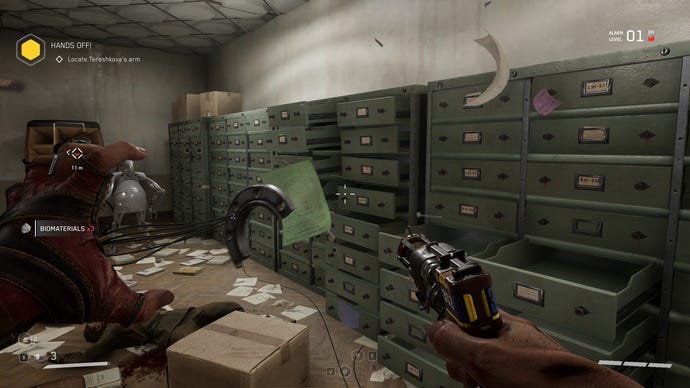
In addition to the synthy OST, Atomic Heart is peppered with licensed songs from Mundfish’s native Russia. Which unfortunately brings us to another issue entirely: what reckoning, if any, this Soviet-themed game has with a nation that back in the real world is waging an unjustifiable war on its neighbours.
Eurogamer has a good overview of the concerns surrounding Atomic Heart’s funding and Mundfish’s unwillingness to explicitly condemn the invasion of Ukraine. But I’m not convinced that partial funding from a company with one dodgy employee is a smoking gun, and frankly, asking the developers to speak out when doing so can carry a prison sentence feels like blaming someone for living under a dictatorship. And while Atomic Heart is being published on the state-affiliated VKPlay platform in Russia, here in the Anglosphere it’s not going to make any meaningful contribution to the Kremlin’s coffers.
In other words, Atomic Heart is probably not a soft power weapon being wielded by the Putin regime. It is, however, dangerously close to USSR fanfiction. For all of BioShock’s bluntness, there was never any doubt that Rapture and Columbia were dystopias, their ruin brought about by the same extremist thought that birthed them. Atomic Heart, by contrast, paints Facility 3826 as a largely earnest hotbed of wonder science, its collapse the fault of just a few bad apples.
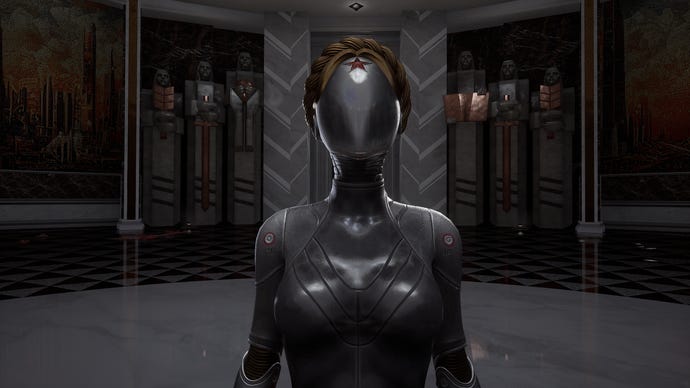
Very, very late on, it does become apparent that some less ethical experiments were going on behind the scenes, though again these crimes are blamed on individuals. Nothing is said of the administration, an even more powerful version of one of the 20th century’s greatest tyrannies, that put them in charge. P-3 himself remains a loyal Soviet to the end, his faith in certain comrades broken but never his belief in the glory of the motherland. Sometimes his bootlicking approaches parody: one piece of filler dialogue has both he and his glove cheerfully share pride in their state while trudging past the withered corpses of its citizens. Only one of them expresses a change in outlook by the time the credits roll, and it ain’t the guy whose eyes we’ve been seeing through.
I’m not outraged by it, but it’s definitely uncomfortable to watch, especially given the real-world circumstances. And even if those didn’t exist, it’s just weird to see a work of science fiction present a failed utopia with so little criticism coded into its reasons for failing. Not having the freedom to speak your mind on a present-day conflict is one thing, but who’s going to bring retribution for needling a regime that ended decades ago? Khrushchev’s ghost?
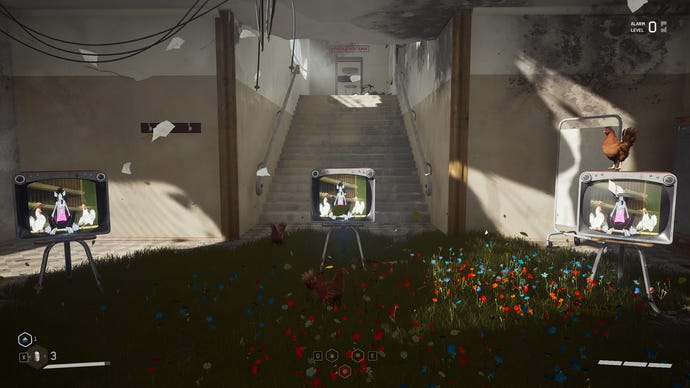
That said, Atomic Heart’s lack of satirical bite might just be one of the most consistent things about it. For every miserable onslaught of respawning bots, there’s an intoxicatingly tense run-and-gun battle. For every work of artistry in the sound design and environments, there’s a scene of utterly sub-par scripting. It’s glorious and tedious, polished and patchwork all the same time, and while there’s an anarchic part of my brain that wants more ambitious-yet-wonky games like it, stronger is my hope that Mundfish’s second game has a tighter grasp on its own strengths and weaknesses.
